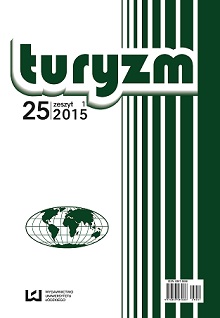Constraints to attendance at visitor attractions: the case of museums, zoos and botanic gardens
DOI:
https://doi.org/10.2478/tour-2014-0017Keywords:
visitor attractions, constraints, attendance, segmentationAbstract
The paper has employed a three-factor model of constraints, which differentiates intrapersonal, interpersonal and structural. The study was carried out on a sample of N = 981 adult residents of Poland. The three most common barriers constraining attendance at attractions were identified: availability, high entrance fees and lack of time. The constraints were found to be related to a number of socio-demographic characteristics, such as gender, age, education, size of place of residence and household income per capita. Three market segments limited by similar constraints and showing similar attraction attendance behaviour were identified with their socio-demographic characteristics.
Downloads
References
CRAWFORD D., GODEY G., 1987, Reconceptualizing barriers to family leisure, Leisure Sciences, 9, pp. 119-127.
Google Scholar
CRAWFORD D., JACKSON E., GODEY G., 1991, Leisure constraints, Leisure Sciences 13, 4, pp. 309-320.
Google Scholar
DAVIES A.J., PRENTICE R.C., 1995, Conceptualising the Latent Visitor to Heritage Attractions, Tourism Management, 16, 7, pp. 491-500.
Google Scholar
DAVIES S., 2005, Still Popular: Museums and their Visitors 1994- 2004, Cultural Trends, 14, 1, pp. 67-105.
Google Scholar
GODBEY G., 1985, Nonuse of public leisure services: A model, Journal of Park and Recreation Administration, 3, 2, pp. 1-12.
Google Scholar
JACKSON E.L., 2005, Leisure constraints research: overview of a developing theme in leisure studies, [in:] E.L. Jackson (ed.), Constraints to leisure, Venture Publishing, Inc, State Colledge, Pensylvania, pp. 3-22.
Google Scholar
JACKSON E.L., HENDERSON K.A., 1995, Gender-based analysis of leisure constraints, Leisure Sciences, 17, pp. 31-51.
Google Scholar
JACKSON E.L., SEARLE M.S., 1985, Recreation Non-Participation and Barriers to Participation: Concepts and Models, Society and Leisure, 8, pp. 693-707.
Google Scholar
JUN J., KYLE G., O’LEARY J., 2008, Constraints to Art Museum Attendance, Journal of Park and Recreation Administration, 26, 1, pp. 40-61.
Google Scholar
KIEŁBASIEWICZ-DROZDOWSKA I., 2001, Zarys rozwoju refleksji teoretycznej nad problematyką rekreacji, [in:] I. Kiełbasiewicz-Drozdowska, W. Siwiński (eds.), Teoria i metodyka rekreacji (zagadnienia podstawowe), AWF w Poznaniu, Poznań, pp. 9-25.
Google Scholar
KOTLER N., KOTLER P., 1998, Museum Strategy and Marketing. Designing Missions. Building Audiences. Generating Revenue and Resources, Jossey-Bass Publishers, San Francisco.
Google Scholar
KOTLER N., KOTLER P., 2001, Can Museum be All Things to All People? Missions, Goals, and Marketing’s Role, Museum Management and Curatorship, 18, 3, pp. 271-287.
Google Scholar
KUNICKI B.J., 1984, Społeczne bariery rekreacji fizycznej, Wyd. AWF, Warszawa.
Google Scholar
LIN, Y.N., 2006, Leisure-A function of museums? The Taiwan perspective, Museum Management and Curatorship, 21, 4, pp. 302-316.
Google Scholar
MANNELL R.C., IWASAKI Y., 2005, Advancing quantitative research on social cognitive theories of the constraint-negotiation process, [in:] E.L. Jackson (ed.), Constraints to leisure, Venture Publishing, Inc, State Colledge, Pensylvania, pp. 261-275.
Google Scholar
MCCARVILLE R.E., SMALE B.J.A., 1993, Perceived constraints to leisure participation within five activity domains, Journal of Park and Recreation Administration, 11, 2, pp. 40-59.
Google Scholar
MCGUIRE F.A., 1984, A factor analytic study of leisure constraints in advanced adulthood, Leisure Sciences, 6, 3, pp. 313-326.
Google Scholar
NADIROVA A., JACKSON, E.L., 1999, How do people negotiate constraints to their leisure? Results from an empirical study, Proceedings of the Ninth Canadian Congress on Leisure Research, Acadia University, Wolfville, pp. 28-31.
Google Scholar
SCOTT D., MUNSON, W., 1994, Constraints to park usage among persons who are economically disadvantaged, Journal of Park and Recreation Administration, 12, 4, pp. 79-96.
Google Scholar
SEARLE M.S., JACKSON E.L., 1985, Socioeconomic variations in perceived barriers to recreation participation among wouldbe participants, Leisure Sciences, 7, 2, pp. 227-249.
Google Scholar
SHAW S.M., HENDERSON K.A., 2005, Gender analysis and leisure constraints: An uneasy alliance, [in:] E.L. Jackson (ed.), Constraints to leisure, Venture Publishing, Inc, State Colledge, Pensylvania, pp. 23-34.
Google Scholar
TIAN S., CROMPTON J., WITT P., 1996, Integrating Constraints and Benefits to Identify Responsive Target Markets for Museum Attractions, Journal of Travel Research, 35, pp. 34-45.
Google Scholar
UM S., CROMPTON J.L., 1992, The Roles of Perceived Inhibitors and Facilitators on Pleasure Travel Destination Decisions, Journal of Ravel Research, 30, pp. 18-25.
Google Scholar
WITT P.A., 1992, The Intersection of Benefits and Constraints, Leisure Constraints Newsletter, 9, pp. 5-6.
Google Scholar
WITT P.A., GOODALE T.L., 1981, The relationships between barriers to leisure enjoyment and family stages, Leisure Sciences, 4, 1, pp. 29-49.
Google Scholar
WOODSIDE A.G., LYSONSKI S., 1989, A General Model of Traveler Destination Choice, Journal of Travel Research, 27, pp. 8-14.
Google Scholar
Downloads
Published
How to Cite
Issue
Section
License

This work is licensed under a Creative Commons Attribution-NonCommercial-NoDerivatives 4.0 International License.










